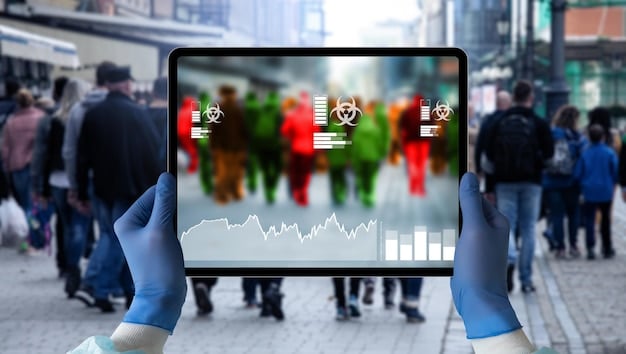The Future of Community Action in 2025: Trends and Innovations

The Future of Community Action: Emerging Trends and Innovative Approaches to Address Social Challenges in 2025 will likely feature increased reliance on technology, data-driven strategies, and collaborative partnerships to tackle complex societal issues effectively.
The year 2025 is fast approaching, bringing with it both opportunities and challenges for community action. Understanding the future of community action: emerging trends and innovative approaches to address social challenges in 2025 is critical for organizations and individuals alike.
How can we best prepare for the changing landscape and ensure that our efforts have a lasting impact? Let’s explore the key trends that will shape community engagement in the coming years.
Understanding the Evolving Landscape of Community Action
Community action has always been a vital part of addressing social issues. However, the future of community action: emerging trends and innovative approaches to address social challenges in 2025 will demand a move away from traditional methods and embracing new strategies to achieve meaningful change.
The Role of Technology in Community Engagement
Technology is set to revolutionize community action, offering new ways to connect, organize, and mobilize resources. Digital platforms and social media have already demonstrated their power to amplify voices and coordinate efforts.
- Utilizing online platforms for community organizing and outreach.
- Leveraging data analytics to identify areas of need and measure impact.
- Employing mobile technology to facilitate communication and engagement.
These technological advancements can streamline operations and enhance the reach of community initiatives. The ability to gather and analyze data will also be crucial for informed decision-making.

The Importance of Collaboration
Collaboration will be key to success in the future of community action: emerging trends and innovative approaches to address social challenges in 2025. By working together, organizations and individuals can pool resources, share knowledge, and create synergistic solutions.
- Forming partnerships between non-profits, government agencies, and businesses.
- Encouraging community participation through inclusive decision-making processes.
- Building networks of support to address complex social problems.
Effective collaboration requires communication, trust, and a shared vision. Organizations must be willing to set aside their individual agendas and work towards a common goal.
In conclusion, understanding the evolving landscape of community action involves leveraging technology and fostering collaboration. These elements will be essential for addressing social challenges effectively in 2025 and beyond. The future of community action: emerging trends and innovative approaches to address social challenges in 2025 is about being adaptable and innovative.
Innovative Approaches to Address Social Challenges
As we look towards the future of community action: emerging trends and innovative approaches to address social challenges in 2025, it is clear that traditional methods alone will not suffice. Social challenges are becoming increasingly complex, requiring innovative approaches that can adapt to changing circumstances and deliver sustainable results.
Data-Driven Decision Making
Making informed decisions based on data is crucial for effective community action. Organizations need to collect, analyze, and interpret data to understand the root causes of social problems and identify the most effective solutions.
- Using data to identify vulnerable populations and target interventions.
- Tracking progress towards goals and making adjustments as needed.
- Sharing data transparently to promote accountability and learning.
Data-driven decision-making also involves using predictive analytics to anticipate future needs and proactively address potential problems. This approach can help organizations to allocate resources more efficiently and maximize their impact.
Community-Led Initiatives
Empowering communities to lead their own development is another key approach. By involving community members in the design, implementation, and evaluation of projects, organizations can ensure that initiatives are culturally appropriate and sustainable.
- Providing training and resources to community leaders.
- Creating opportunities for community members to participate in decision-making.
- Supporting grassroots movements that address local needs.
Community-led initiatives are more likely to succeed because they are based on a deep understanding of local contexts and priorities. They also foster a sense of ownership and responsibility, which is essential for long-term sustainability.
Implementing innovative approaches such as data-driven decision making and community-led initiatives are essential for the future of community action: emerging trends and innovative approaches to address social challenges in 2025. These strategies empower communities and ensure resources are used efficiently and effectively.
Emerging Trends Shaping Community Initiatives
Identifying and understanding emerging trends is vital for the future of community action: emerging trends and innovative approaches to address social challenges in 2025. These trends can provide insights into the changing needs and priorities of communities, allowing organizations to adapt their strategies and remain relevant.
Focus on Mental Health and Well-being
Mental health is increasingly recognized as a critical social issue. Community initiatives are expanding to address the mental health needs of vulnerable populations, offering support, counseling, and education.
This includes initiatives that promote mental health awareness, reduce stigma, and provide access to mental health services. By addressing mental health issues proactively, communities can improve overall well-being and resilience.
Addressing Climate Change at the Local Level
Climate change is a global challenge with local impacts. Community initiatives are playing a crucial role in mitigating climate change and adapting to its effects. This includes promoting sustainable practices, reducing carbon emissions, and building resilience to extreme weather events.

Communities are also working to educate residents about climate change and encourage them to take action. By empowering individuals to make sustainable choices, communities can collectively contribute to a more sustainable future.
The emerging trends of focusing on mental health and addressing climate change are essential for the future of community action: emerging trends and innovative approaches to address social challenges in 2025. These areas require proactive and community-driven solutions.
The Importance of Measuring Impact and Ensuring Accountability
Measuring the impact of community action initiatives is essential for demonstrating their value and ensuring accountability. By tracking outcomes, organizations can assess the effectiveness of their programs, make improvements, and attract funding. The future of community action: emerging trends and innovative approaches to address social challenges in 2025 will rely on measurable progress.
Setting Clear Goals and Objectives
Before launching a community initiative, it is important to set clear goals and objectives. These goals should be specific, measurable, achievable, relevant, and time-bound (SMART). This provides a framework for evaluating progress and determining whether the initiative is having the desired impact.
Clear goals also help to align the efforts of different stakeholders and ensure that everyone is working towards the same objectives. By setting ambitious but realistic goals, organizations can inspire action and drive progress.
Using Data to Track Progress
Collecting and analyzing data is crucial for tracking progress towards goals. Organizations should identify key indicators and establish systems for collecting data on a regular basis. This data can then be used to assess whether the initiative is on track and make adjustments as needed.
Sharing data transparently with stakeholders is also important for promoting accountability. This allows others to see what is working and what is not, and provides an opportunity for feedback and collaboration.
By measuring impact and ensuring accountability through clear goals and data tracking, the future of community action: emerging trends and innovative approaches to address social challenges in 2025 will be more effective and transparent.
Building Sustainable Community Initiatives for the Future
Sustainability is a key consideration for the future of community action: emerging trends and innovative approaches to address social challenges in 2025. To create lasting change, initiatives must be designed to be sustainable over the long term, both financially and environmentally. This requires careful planning, resource management, and community involvement.
Diversifying Funding Sources
Relying on a single funding source can make community initiatives vulnerable to funding cuts. Diversifying funding sources can help to ensure financial stability and allow initiatives to continue operating even when one source of funding dries up.
This may involve seeking grants from multiple foundations, pursuing partnerships with businesses, and launching fundraising campaigns. By diversifying funding sources, organizations can build a more resilient financial base.
Promoting Environmental Stewardship
Environmental stewardship is another key aspect of sustainability. Community initiatives should be designed to minimize their environmental impact and promote sustainable practices.
- Reducing waste and promoting recycling.
- Conserving energy and water.
- Protecting natural resources.
By incorporating environmental considerations into every aspect of their work, organizations can contribute to a healthier and more sustainable future. This also demonstrates a commitment to social responsibility, which can enhance their reputation and attract support.
By building sustainable community initiatives through diversified funding and promoting environmental stewardship, the future of community action: emerging trends and innovative approaches to address social challenges in 2025 can achieve long-term and meaningful change.
Conclusion
In summary, the year 2025 holds significant opportunities and challenges for community action. By embracing technology, fostering collaboration, and adopting innovative approaches, organizations and individuals can effectively address social problems and create positive change.
Looking forward, the key to success will be adaptability, innovation, and a commitment to sustainability. By understanding the future of community action: emerging trends and innovative approaches to address social challenges in 2025, we can all contribute to building stronger, more resilient communities.
| Key Point | Brief Description |
|---|---|
| 🚀 Technology Integration | Utilizing digital platforms for outreach and data analytics for informed decisions. |
| 🤝 Collaborative Partnerships | Forming alliances between nonprofits, government, and businesses for shared goals. |
| 🌱 Sustainable Initiatives | Prioritizing environmental stewardship and diversified funding for long-term impact. |
| 📊 Data-Driven Decisions | Using data to identify needs, track progress, and ensure accountability in community action. |
Frequently Asked Questions
Technology, collaboration, and data-driven decision-making are key drivers. Additionally, a focus on sustainability and addressing mental health challenges are becoming increasingly important.
Technology can enhance communication, streamline operations, and facilitate data collection. It also allows for better outreach and engagement with community members.
Collaboration allows organizations to pool resources, share knowledge, and create synergistic solutions. It fosters a sense of shared responsibility and promotes effective problem-solving.
Data-driven decision-making involves using data to inform strategies and track progress. It helps organizations to allocate resources efficiently and maximize their impact.
Diversifying funding sources and promoting environmental stewardship are key. Initiatives should also involve community members in the design and implementation of projects.
Conclusion
In summary, the year 2025 holds significant opportunities and challenges for community action. By embracing technology, fostering collaboration, and adopting innovative approaches, organizations and individuals can effectively address social problems and create positive change.
Looking forward, the key to success will be adaptability, innovation, and a commitment to sustainability. By understanding the future of community action: emerging trends and innovative approaches to address social challenges in 2025, we can all contribute to building stronger, more resilient communities.





